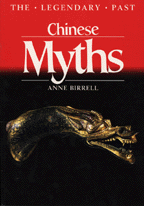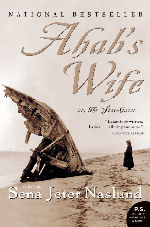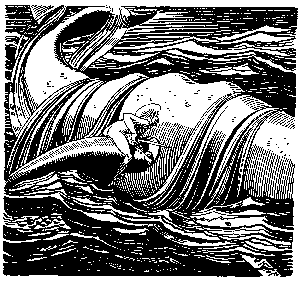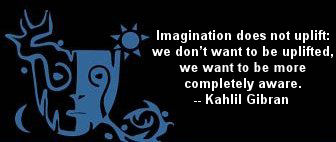|

Mythopoesis from Moby Dick to Ahab's Wife
by William Doty, Ph. D.,
Mythopoesis is a term built from the Greek verb mythopoiein or the noun mythopoia, the making of story or myth (earlier spelling was mythopoiea). Poetry is a sort of making, but the modern term mythopoesis is no more unmarked than "poetry" itself, which now implies a formal quality by means of which language is orchestrated-usually rhymed and set in stanzas. What I focus upon here is the retreading of mythological materials in subsequent versions or adaptations — mythopoesis.
 This phenomenon came into contemporary literary discussions largely thanks to Harry Slochower's Mythopoesis This phenomenon came into contemporary literary discussions largely thanks to Harry Slochower's Mythopoesis . "He had in mind situations where meanings of mythical accounts had been re-visioned, the original literal tellings of myths and stories transformed into symbolically new versions" (Doty, Mythography, 20). . "He had in mind situations where meanings of mythical accounts had been re-visioned, the original literal tellings of myths and stories transformed into symbolically new versions" (Doty, Mythography, 20).
It also can be used to name "that process by which new myths are created or old myths are extended to include new dimensions" (Batto 12, cited ibid., 21) — precisely what Bernard Batto recognized in the sequential re-writings (redactions) of Israelite scriptures in the various re-editings of Torah over a couple of centuries. In his work, redactional re-visionings are explicated as ideological-theological overwritings of earlier editorial shapings. Similarly, in studies of the early-Christian gospels, specific biases of the various writers are analyzed by means of "redaction criticism."
 Another politicized meaning can be found in Anne Birrell's Chinese Mythology: An Introduction Another politicized meaning can be found in Anne Birrell's Chinese Mythology: An Introduction , where it names a characteristic of later Chinese myth: here it refers to an "attempt to explain, rationalize, embellish, humanize, or historicize the mythical beings" (1993: 387, quo. Doty 21). In her more recent Chinese Myth and Culture, she notes how the famous James Legge in his Chinese Classics actually performs mythopoetic work when he takes parallel passages from several works and fuses them together; this is "the invention of a new myth by adding bits and pieces from other versions" (2006, 116). His readings often miss crucial aspects of the original sources, as "His reading of [a myth] demonstrates a credal, or theological, approach rather than the mythological" (117). She can also speak rather negatively of mythopoetic "reconstruction" and "manipulation" (172, 204). , where it names a characteristic of later Chinese myth: here it refers to an "attempt to explain, rationalize, embellish, humanize, or historicize the mythical beings" (1993: 387, quo. Doty 21). In her more recent Chinese Myth and Culture, she notes how the famous James Legge in his Chinese Classics actually performs mythopoetic work when he takes parallel passages from several works and fuses them together; this is "the invention of a new myth by adding bits and pieces from other versions" (2006, 116). His readings often miss crucial aspects of the original sources, as "His reading of [a myth] demonstrates a credal, or theological, approach rather than the mythological" (117). She can also speak rather negatively of mythopoetic "reconstruction" and "manipulation" (172, 204).
Any objective account of American reinterpretations of our colonial and revolutionary history will of course disclose such impulses, as later generations seek to cloak their own necessary modifications in the guise of interpreting what the Founding Fathers (and hopefully Mothers) really intended, especially with respect to the Constitution of the United States.
 A winter solstice gift from one Birmingham writer, Wendy Bruce, led me to a fascinating novel by another, originally from that city. Ahab's Wife: Or, The Star-gazer A winter solstice gift from one Birmingham writer, Wendy Bruce, led me to a fascinating novel by another, originally from that city. Ahab's Wife: Or, The Star-gazer , by Sena Jeter Naslund, plays constantly upon "The" American Novel by Herman Melville. It's a great read, long — 666 pages — but it keeps one engaged with this epic tale of a female hero and all her varying circumstances and relationships (three husbands, the first two notably unstable creatures, the second being Ahab himself). The ignored females of nineteenth-century fiction are given full voice here, even as such sympathetic views frequently slip into twen-cen sensitivities. The novel certainly stands on its own, but is particularly interesting for its mythopoetic use of Moby Dick. , by Sena Jeter Naslund, plays constantly upon "The" American Novel by Herman Melville. It's a great read, long — 666 pages — but it keeps one engaged with this epic tale of a female hero and all her varying circumstances and relationships (three husbands, the first two notably unstable creatures, the second being Ahab himself). The ignored females of nineteenth-century fiction are given full voice here, even as such sympathetic views frequently slip into twen-cen sensitivities. The novel certainly stands on its own, but is particularly interesting for its mythopoetic use of Moby Dick.
Of course the many reflections of Moby Dick in Ms. Naslund's novel made a strong impression upon me, yet it had been decades since I had read that work. Hence when subsequently I returned to the Melville, and realized the huge extent to which his characters had become — at least in name — hers, I was quite amazed. For instance: Starbuck, Pip, Ishmael, Elijah, Peleg and Bildad, Queequeg, Pequod, Fedallah. And indeed the literary style of the Epilogue, extremely short chapter lengths, and various "scientific" digressions.
Naslund's borrowing from (and often transforming) the Melville is solidly augmented as she cites writings of his contemporaries: page thirteen in the appended reader's notes lists "Fourteen Books that Influenced the Creation of" the novel — the list, presumably, compiled by Naslund. Included are Uncle Tom's Cabin, Jane Eyre, David Copperfield, Toni Morrison's Beloved (our contemporary), Hawthorne, Wordsworth, Coleridge, Emerson, Dickinson, and feminist Margaret Fuller's Woman in the Nineteenth Century (published in 1845). At times the references to these older authors lend—no doubt intentionally, an antiquarian, somewhat fustian (pompous) atmosphere, but fear not! Naslund provides fictional excitement enough to keep the reader's eye engaged on every page.
There are convoluted plot moves sufficient to give the novel aspects of a long thriller—and the author is such a skilled writer that she always has surprises, even when about two-thirds of the way, we are suddenly revisiting a crucial scene from the beginning of the book.
 There is a certain irony to be sure, in Naslund's renderings, since Melville's Moby Dick enfolds within its own nineteenth-century pages many mythopoetic revisionings—notably of the biblical Job's references to Leviathan and prophecies in the book of Ezekiel, but also allusions to Greek and Roman mythical figures as well as the medieval George and the Dragon story. Such allusion is obvious in Rockwell Kent's striking woodblock print on page 527 of the Modern Library edition, where the naked harpooner apparently rides a porpoise: the artist expatiates (slowly unpacks) what the plot is developing, including scientific details—this is precisely why I purchased this illustrated edition as my second copy of the epic. There is a certain irony to be sure, in Naslund's renderings, since Melville's Moby Dick enfolds within its own nineteenth-century pages many mythopoetic revisionings—notably of the biblical Job's references to Leviathan and prophecies in the book of Ezekiel, but also allusions to Greek and Roman mythical figures as well as the medieval George and the Dragon story. Such allusion is obvious in Rockwell Kent's striking woodblock print on page 527 of the Modern Library edition, where the naked harpooner apparently rides a porpoise: the artist expatiates (slowly unpacks) what the plot is developing, including scientific details—this is precisely why I purchased this illustrated edition as my second copy of the epic.
Of course, in the twentieth century, author C. S. Lewis could still frequently harvest and revise — but in his case we recognize that revising/retelling can only too easily slip into the closed system of allegory, wherein one set of ciphers intends a second set of meanings and connotations. What we now see as problematic is that once the secondary applications are revealed, the specific aspects of the original can be dropped, the cask in which the pearls are concealed. (Note the proceedings of the Mythopoeic Society, founded in 1967, focused primarily upon the works of Tolkien, Lewis, and Charles Williams)
Accordingly, the allegory of Augustine of Hippo suggested that in Jesus' parable (better: moral tale) of the Good Samaritan, "a certain man" is Adam himself; thieves are the devil and his angels, who strip the man of his immortality and beat him, by persuading him to sin. The binding of the wounds is the restraint of sin; oil the comfort of good hope; wine the exhortation to work with fervent spirit. The beast of burden represents the flesh in which God deigned to come to earth; the innkeeper is the Apostle Paul...and on and on (from Quaestiones Evangeliorum, II.19, abridged by Dodd, 1-2). I regard such treatments as the furthest-possible escapes from the electric-metaphoric teachings of the historical Jesus.
Perhaps one may conceive writing — any sort of it — as constant mythopoeia, insofar as the very bounds of language are created and abetted by poetic metaphor. The poiein (literally "making," perhaps "making poetically") of mythopoesis acknowledges our common past, our mutual sharing of images, themes, archetypes, metaphors that remind us that we are always only muttering (a word cognate with mythos) at the threshold of those significant meanings by which we set our social and individual goals and recognize energies beyond our ability to control them (the traditional term here has been "the sacred").
While "recycle" may be a trick-word from the late twen-cen, it appears in this instance as a refreshing, re-creative energy. We ought to seek always insight again, anew. The Modernist slogan, "Make it New!" becomes the postmodernist "Make it New AGAIN!" And what a voluptuous wonderland of mythological figures and stories share our huge warehouses of the imagination, no cover charge required.
Works Cited:
Batto, Bernard. 1992. Slaying the Dragon: Mythmaking in the Biblical Tradition. Louisville: Westminster/John Knox.
Birrell, Anne. 1993. Chinese Mythology: An Introduction. Baltimore: Johns Hopkins UP.
- --. 2006. Chinese Myth and Culture. Cambridge UK: McGuinnes China Monographs.
Dodd, C. H. 1961. The Parables of the Kingdom. New York: Scribner's.
Doty, William G. 2000. Mythography: The Study of Myths and Rituals. 2nd ed. Tuscaloosa: U of Alabama P.
Melville, Herman. 1930 [orig. 1851, Modern Library printing, 1982]. Moby Dick or The Whale. New York: Modern Library
Naslund, Sena Jeter. 1999. Ahab's Wife or, The Star-Gazer. New York: Harper Perennial-HarperCollins (2005).
Slochower, Harry. 1970. Mythopoesis: Mythic Forms in the Literary Classics. Detroit: Wayne State UP.
 William Doty, Ph. D.,
William Doty, Ph. D.,
is Professor Emeritus of Humanities and Religious Studies at the University of Alabama and former editor of Mythosphere: A Journal for Image, Myth and Symbol. Dr. Doty is a prolific writer, translator, and editor who has published more than twenty books and seventy essays in a wide range of journals on topics including religious studies, anthropology, psychology, classics, and art criticism. His best known books include Mythography: The Study of Myths and Rituals, Myths of Masculinity, and Myth: A Handbook.
Return to Passages Menu
Subscribe to the Passages e-zine
|

